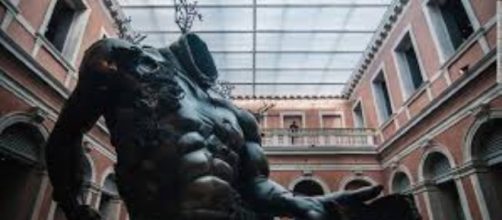British artist Damien Hirst is back with what he does best, call it novelty art. He’s probably known mostly for “Mother and Child Divided” - four giant fish tanks holding a cow and her calf, each bisected with all their halves floating in formaldehyde. Anything for a splash, this guy, and the art world fell in with what may fairly be seen as a sick joke on maternity. Instead, the work earned him England’s coveted Turner prize. A few years later, he came back with a dead tiger shark that sold at auction for $12 million. So you found yourself wondering what he came up with this time.
Making it big
From images sent from Venice where 190 sculptures are disgorged throughout a palace and an old customs hall, Hirst went for whopping as well as where-does-it-all-end profusion. This is very Trumpian in a way. As the Donald famously said, “You have to think anyway, so why not think big?” Consider images of the 69-foot-tall mountain man Hirst titled “Demon,” and see if it doesn’t put you in mind of ancient Egyptian tomb immensities like the monuments of Pharaoh Amenhotep III, a.k.a. the Colossi of Memnon. If nothing else, this new work, which shows under the flag “Treasures from the Wreck of the Unbelievable,” struts novelty. That’s as far as this column can go at the moment. But two English art critics who have seen this show up close are markedly divided on the merits.
Thumbs down
Alastair Sooke of the Telegraph seemed put off by Hirst’s new show even before seeing it with what he called the “stage-managed hype” that preceded it. This shouldn’t have surprised him since Hirst has always been good at selling himself. As for the show, he saw it as unbelievable, but not in a good way. By the very scale of the sculptures, he expected them to come off "grand and epic." Instead, he slammed them as “tawdry and low-rent, tinny and fake,” and crowned the lot “a bloated folly.” All of which explains why he came away feeling “bored.” Finally, he signed off with the zinger that “Treasures from the Wreck of the Unbelievable” will be the shipwreck of Hirst’s career.
A rave
Not if the rest of the art world thinks like the Guardian critic Jonathan Jones who went gaga for the show.
The tipoff came when he began his review, asking himself when he last saw work that delighted him as much, and the answer was Hirst’s fine art in formaldehyde: “The young artist who put a tiger shark in a glass tank never died, after all, and we who lost faith in him look like fools for failing to believe.” Praising the Venice work, Jones tagged HIrst “audaciously and beautifully reborn.” In case you find these conflicting reviews confusing, something Jones said may help: “It takes a kind of genius to push kitsch to the point where it becomes sublime.” This column has no words.

